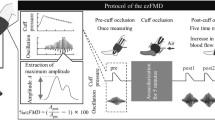Abstract
Measurement of flow-mediated dilatation (FMD) is the conventional non-invasive method for assessment of endothelial function; however, it requires an expensive ultrasound system and high levels of technical skill. Therefore, we developed a novel method for measurement of endothelial function, namely, measurement of ezFMD. ezFMD estimates the degree of vasodilatation from the oscillation signals transmitted to a sphygmomanometer cuff attached to the upper arm. The objective of this study was to validate the principle underlying the measurement of ezFMD, and to evaluate the repeatability of the ezFMD measurements. We observed the blood vessel behavior and oscillometric pattern in ten subjects. When the cuff was inflated to the level of the mean blood pressure, the oscillation amplitude increased with increasing degree of vasodilatation. In experiment to evaluate the repeatability of the ezFMD measurement, the average difference between the paired measurements was 3.7 %, the standard deviation was 11.5 %, and the average coefficient of variation value for the 11 paired measurements was 23.7 %. These results suggest the validity of the principle underlying the measurement of the ezFMD for the assessment of endothelial function. And, this study suggests that the repeatability of the ezFMD measurements is superior to that of the conventional measurement of FMD.





Similar content being viewed by others
References
Bank AJ, Wilson RF, Kubo H, Holte JE, Dresing TJ, Wang H (1995) Direct effect of smooth muscle relaxation and contraction on in vivo human brachial artery elastic properties. Circ Res 77:1008–1016
Bland JM, Altman DG (1986) Statistical methods for assessing agreement between two methods of clinical measurement. Lancet 1:307–310
Celermajer DS, Sorensen KE, Gooch VM, Spiegelhalter DJ, Miller OI, Sullivan ID, Lloid JK, Deanfield JE (1992) Non-invasive detection of endothelial dysfunction in children and adults at risk of atherosclerosis. Lancet 340:1111–1115
Chinn S (1999) The assessment of methods of measurements. Stat Med 9:351–362
Corretti MC, Anderson TJ, Benjamin EJ, Celermajer D, Charbonneau F, Creager MA, Deanfield J, Dlexler H, Gerhard-Herman M, Herrington D, Vallance P, Vita J, Vogel R (2002) Guidelines for the ultrasound assessment of endothelial-dependent flow mediated vasodilation of the brachial artery: a report of the international brachial artery reactivity task force. J Am Coll Cardiol 39:257–265
Harris RA, Padilla J, Rink LD, Wallance JP (2006) Variability of flow-mediated dilation measurements with repetitive reactive hyperemia. Vasc Med 11:1–6
Idei N, Higashi Y, Soga J, Hata T, Hidaka T, Fujii Y, Fujimura N, Mikami S, Maruhashi T, Yoshizumi M, Kihara Y (2010) A new noninvasive method for assessment of endothelial function: enclosed zone flow-mediated vasodilation (ezFMD) Circ J 74 (Suppl I):498 (abstract)
Malik J, Wichterle D, Haas T, Melenovsky V, Simek J, Stulc T (2004) Repeatability of noninvasive surrogates of endothelial function. Am J Cardiol 94:693–696
Mauck GW, Smith CR, Geddes LA, Bourland DJ (1980) The meaning of the point of maximum oscillations in cuff pressure in the indirect measurement of blood pressure—part II. J Biomech Eng 102:28–33
Meyer B, Moertl D, Strecker K, Huelsmann M, Kulemann V, Neunteufl T, Pacher R, Berger R (2005) Flow-mediated vasodilation predicts outcome in patients with chronic heart failure: comparison with B-type natriuretic peptide. J Am Coll Cardiol 46:1011–1018
Michard F (2005) Changes in arterial pressure during mechanical ventilation. Anesthesiology 103:419–428
Peretz A, Leotta DF, Sullivan JH, Trenga CA, Sands FN, Aulet MR, Paun M, Gill EA, Kaufman JD (2007) Flow mediated dilation of the brachial artery: an investigation of methods requiring further standardization. BMC Cardiovasc Disord 7:11
Ramsey M (1979) Normotensive automatic determination of mean arterial pressure. Med Biol Eng Comput 17:11–18
Roman MJ, Naqvi TZ, Gardin JM, Gerhard-Herman M, Jaff M, Mohler E (2006) Clinical application of noninvasive vascular ultrasound in cardiovascular risk stratification: a report from the American Society of Echocardiography and the Society of Vascular Medicine and Biology. J Am Soc Echocardiogr 19:943–954
Ross R (1999) Atherosclerosis—an inflammatory disease. N Engl J Med 340:115–126
Soga J, Nishioka K, Nakamura S, Umemura T, Jitsuiki D, Hidaka T, Teragawa H, Takemoto H, Goto C, Yoshizumi M, Chayama K, Higashi Y (2007) Measurement of flow-mediated vasodilation of the brachial artery—a comparison of measurements in the seated position and supine position. Circ J 71:736–740
Yoboah J, Folsom AR, Burke GL, Johnson C, Polak JF, Post W, Lima JA, Crouse JR, Herrington DM (2009) Predictive value of brachial flow mediated dilation for incident cardiovascular events in a population-based study. Circulation 120:502–509
Author information
Authors and Affiliations
Corresponding author
Rights and permissions
About this article
Cite this article
Ukawa, T., Takayanagi, T., Morimoto, H. et al. Novel non-invasive method of measurement of endothelial function: enclosed-zone flow-mediated dilatation (ezFMD). Med Biol Eng Comput 50, 1239–1247 (2012). https://doi.org/10.1007/s11517-012-0955-z
Received:
Accepted:
Published:
Issue Date:
DOI: https://doi.org/10.1007/s11517-012-0955-z




